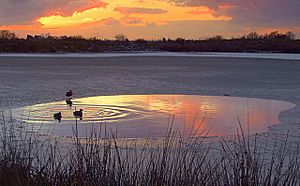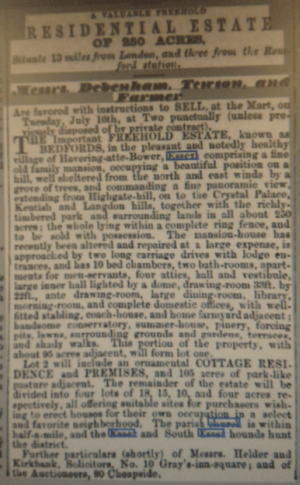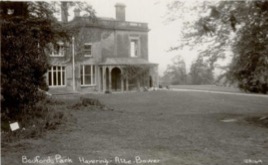Bedfords Park facts for kids
Quick facts for kids Bedfords Park |
|
|---|---|
 |
|
| Type | Nature reserve |
| Location | Havering-atte-Bower, Havering, Greater London |
| OS grid | TQ 520 922 |
| Area | 87 hectares |
| Managed by | Havering Council |
Bedfords Park is a big public park in Havering-atte-Bower, Havering, England. It's about 215 acres (87 hectares) in size. This park is one of three large green spaces in the area, along with Havering Country Park and Pyrgo Park.
Bedfords Park is a special place for nature. It's known as a Site of Metropolitan Importance for Nature Conservation and a local nature reserve. It even won a Green Flag Award in 2007 for being a great park. Havering Council looks after the park, and the Essex Wildlife Trust runs the visitor centre.
| Top - 0-9 A B C D E F G H I J K L M N O P Q R S T U V W X Y Z |
Exploring Bedfords Park
Bedfords Park sits on a hill that slopes down towards the south. From the top, which is 110 metres high, you can see amazing views across east London and even over the River Thames to Kent.
The park has different types of land. You'll find mixed parkland and woods with trees that lose their leaves in autumn. There's also a pond called the Round Pond, which stays full of water because of the special clay soil underneath.
You can get into the park with a car from Broxhill Road on the north side. If you're walking, there are paths from Lower Bedfords Road on the south side and another path from Orange Tree Hill.
A Look Back in Time: Park History
The land that makes up Bedfords Park used to be two separate areas called Bedfords and Earls. The name "Bedfords" might come from families like Robert de Bedford (from 1285) or John Bedford (from 1362). The Earls area was once owned by King John in 1212!
Later, in 1452, a man named Thomas Cooke, who became the Lord Mayor of London, bought both areas. They stayed together as part of the Gidea Hall estate for about 200 years. After that, the land changed owners many times. By 1678, Robert Wolley owned both Bedfords and Earls.
The Bedfords Park Mansion
In 1771, a man named John Heaton bought the land. He built a new, two-storey brick house at Bedfords. He lived there until he passed away in 1818. Around the same time (about 1777), the road that used to go through the park was closed by the owner. This is when the park started to look much like it does today, with the same tree lines and boundaries.
The property stayed in the Heaton family for two generations. It was even advertised for sale in a newspaper in 1867!
In 1870, Henry R. Stone bought the park. His son, Henry J. Stone, was the last owner of the manor. In 1933, his wife sold parts of Bedfords to Romford Urban District Council.
The council opened Bedfords Park to the public in 1934. They even turned the mansion into a museum about natural history, showing stuffed birds and animals from the local area. Around this time, a group of red deer were also brought to live in the park.
During World War II, Bedfords House was used by the Auxiliary Fire Service. After the war, it became a council archive, but it slowly fell apart and was taken down in 1959. In the 1960s, a cafe was built where the house used to be, but it also closed in the 1980s.
Today, you can still see where the old road used to be. It follows the entrance drive, past the old stable building (which is the only part of the mansion left), and down the hill. This path is lined with beautiful Horse Chestnut trees. The place where the mansion once stood is now home to the Visitor Centre, run by the Essex Wildlife Trust.
Queen Anne's Oak
There was a very old oak tree next to the mansion and the deer area. It was called Queen Anne's Oak. Legend says that Queen Anne herself sat by this tree when she visited the estate! People tried very hard to keep the tree alive for a long time. They even built bricks around its base and used metal belts to support it.
The tree was mentioned in a book from 2005, which said:
The "Old Preserved Oak Tree" Syd mentioned was known as the "Queen Anne Oak". Because of its increased deterioration (it had more wooden support and brickwork than its own timber!) Council decided to remove it in the late 1980s. However the Mayor planted a replacement Oak Tree close by - with a plaque which commemorated the Old (about 400 year old) tree. Acorns were also gathered from the Old tree by pupils of Dame Tipping School, Havering Village. They potted the acorns with a view to growing young oaks for later planting. Could I please ask that somebody still living close to Romford contact the school to see if any of the Oaks, descendants of the "Queen Anne Oak" were ever planted and, if so, where?
In 2015, a new oak tree was planted exactly where the old one stood, to remember the famous Queen Anne's Oak.





